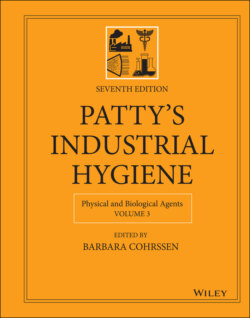Читать книгу Patty's Industrial Hygiene, Physical and Biological Agents - Группа авторов - Страница 16
2.1 Natural Radiation
ОглавлениеCosmic radiation, when it enters the earth's atmosphere, consists mainly (90%) of high kinetic energy protons, with the remaining 10% being alpha particles, neutrons, and electrons. The interaction of these very high‐energy particles with the atmosphere leads to the production of certain radioactive isotopes (notably tritium (3H) and radiocarbon (14C)), muons (extremely high‐energy, heavy electrons that become ordinary electrons when they lose their energy), and gamma rays. Cosmic ray intensity varies according to altitude and latitude. The atmosphere acts as a shield whose total thickness is equivalent to about 30 ft (approximately 9 m) of water. Therefore, cosmic ray intensity is lowest at sea level, and increases with increasing altitude. In the United States, the average dose from cosmic rays at sea level is about 30 millirems (mrem) (0.3 mSv) per year. The mrem is a unit of radiation dose equivalent that is used for safety and regulatory purposes, while the sievert is the SI unit for radiation dose equivalent. One Sievert is equivalent to 100 rems. In Denver, CO, at an altitude of one mile (1.6 km), the cosmic ray dose rate is about twice that at sea level. Thus, jet aircraft crew members receive significant radiation doses in the course of their work (although very much less than the regulatory dose limit for occupational exposure).
The latitude effect is due to the earth's magnetic field. Charged cosmic ray particles entering the earth's atmosphere in the equatorial region travel in a direction that is nearly perpendicular to the earth's magnetic field, whereas charged particles that enter the atmosphere at higher latitudes cross the magnetic lines of force at a glancing angle. The equatorial particles thus experience a much greater magnetic force, which turns them away from their initial path toward the earth, than the particles that enter at the high latitudes. The cosmic ray intensity is therefore lowest at the equator, and increases continuously as the latitude, both north and south, increases.
Terrestrial radiation comes mainly from three different groups of naturally occurring radioisotopes. Primordial radioisotopes that were present when the earth was formed are
238U, T1/2 = 4.5 × 109 years
235U, T1/2 = 7.1 × 108 years
232Th, T1/2 = 1.4 × 1010 years
40K, T1/2 = 1.3 × 109 years.
These radioactive elements are ubiquitous; average uranium and thorium concentrations in the soil are of the order of several parts per million. Natural potassium, which is abundant in the earth's crust, contains approximately 0.012% of 40K.
